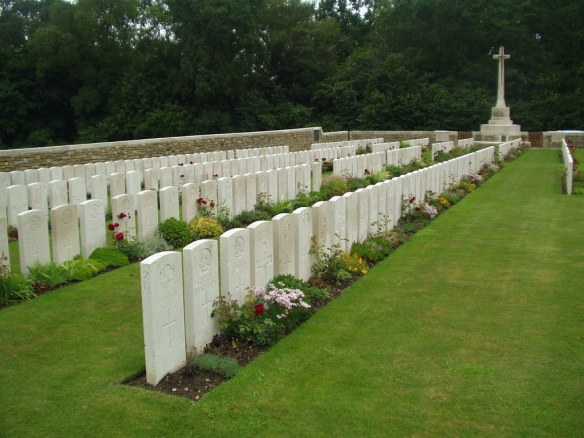Private George Hardwick
22307, 9th Bn., Seaforth Highlanders
who died of wounds on 1st June 1918, aged 19
Remembered with Honour
Barrow Hill Memorial
Staveley Parish Memorial
Ebblinghem Military Cemetery (I. F. 11)
Robert Hardwick was born in Staveley and, like his father and grandfather before him, he worked as a carpenter. His family lived at Ivy Cottage, one of the Dukes’ Cottages on Hollingwood Common, close to the Chesterfield Canal. His future wife, Alice Bacon, was from Pinxton and had been “in service” from a young age. The couple married in 1878 and made their home at Crofts Yard, off the High Street in Staveley, where Robert carried out his joinery work and where their children, John Thomas and Sarah Ann, were born.
 The couple moved back to live on Hollingwood Common and, by 1891, the family had grown to include Joseph, Mary Elizabeth, Alice and Benjamin.
The couple moved back to live on Hollingwood Common and, by 1891, the family had grown to include Joseph, Mary Elizabeth, Alice and Benjamin.
Although it is not clear if Robert worked as a carpenter for the railways, the family were living in the Great Central Railway Cottages on Hollingwood Common in 1901. These cottages still stand on what is now Station Road, at Hollingwood. Sons Robert, William, GEORGE HENRY and Charles completed the family of 10 children.
Tragedy hit the family, in 1908, when Alice died and Robert was left to take care of his family. He moved to live at 10, Lees Buildings by the canal where he carried on working as a carpenter and contractor. The younger boys, Robert 17, William 15 and Charles 10, lived with him in the 4 rooms of the cottage. Joseph, Sarah and Mary Elizabeth had all married and moved out and Alice went to live with some cousins in Pinxton.
John Thomas had joined the army in 1903 and served for 3 years with the 2nd battalion., Sherwood Foresters (8627) but was, by this time, in the Reserves and was living with his wife and family just a few doors away from his father. Benjamin had also had a short spell in the army with the Sherwood Foresters (10773) but had been discharged medically unfit and was boarding with another family at the Lees Buildings. 14 year old school boy, George, was living with his aunt and uncle, Elizabeth and William Hardy, in Lowgates, Staveley.
When war was declared on 4th August 1914, Corporal John Thomas Hardwick was re-called to the 2nd battalion, Sherwood Foresters and was posted to the British Expeditionary Force on 8th September 1914. He was wounded in action on 28th February 1915 with a gunshot wound to his arm and returned to England on a hospital ship. He recovered and returned to France on 17th August 1915 where he was promoted to the rank of Sergeant in October. John was discharged from the army on 29th January 1916 when his 12 year period of service expired and was awarded the 1914 star, the British War Medal and the Victory Medal.
Young George Hardwick enlisted at Doncaster as a Private in the 9th (Service) Battalion, Seaforth Highlanders (Ross-shire Buffs, the Duke of Albany’s) a kilted regiment who wore the MacKenzie tartan. This unusual regimental posting suggests the probability that George was conscripted when he reached 18 years of age in 1917.
The battalion had been in France since May 1915 under command of the 9th (Scottish) Division when George joined them. His divisional pioneer battalion was an extra battalion, not forming part of a brigade, and was normally used for such tasks as digging trenches, observation posts and gun pits, building huts, laying tracks and maintaining roads, although being fully trained as infantry and able to fight in that capacity as required. Almost all of the work, even when not in or in front of the frontline trenches, was well within range of enemy artillery. The battalion were in the thick of it during the German advances in 1918 in The Salient and the Division as a whole was regarded by many as one of the best fighting formations of 1914-18.
George died of wounds on 1st June 1918, aged 19. In the absence of any service records, details of how he was wounded are unconfirmed, but could have been the result of a trench collapse, enemy shelling or, perhaps, a sniper’s bullet. He is buried in plot I. F. 11 at Ebblinghem Military Cemetery which was begun by the 2nd and 15th Casualty Clearing Stations, who came to Ebblinghem in April 1918 at the beginning of the German offensive, and which was then 20 kilometres west behind the front line. There are 2 other men of the 9th Seaforth’s buried here who both died on 29th May which could also have been when George was wounded.
George Henry Hardwick was posthumously awarded the British War Medal and the Victory Medals.
The Register of Soldiers Effects contains records detailing the money owed to soldiers of the British Army who died in service from 1901 to 1929. George’s record shows that his beneficiary was his nephew, Albert Hadfield, son of his sister Alice.
©Ann Lucas





